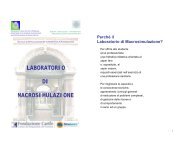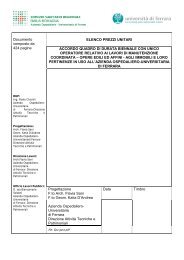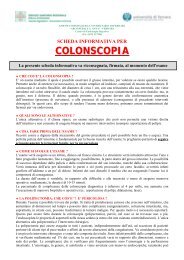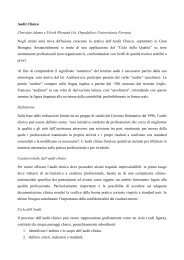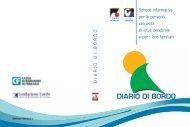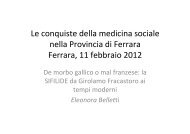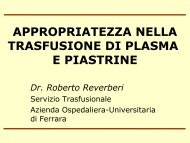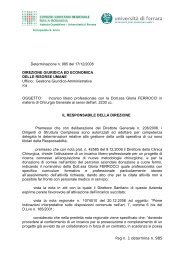La terapia endoscopica con Botulino nella vescica iperattiva-G.P. ...
La terapia endoscopica con Botulino nella vescica iperattiva-G.P. ...
La terapia endoscopica con Botulino nella vescica iperattiva-G.P. ...
Create successful ePaper yourself
Turn your PDF publications into a flip-book with our unique Google optimized e-Paper software.
<strong>La</strong> <strong>terapia</strong> <strong>endoscopica</strong><br />
<strong>con</strong> <strong>Botulino</strong> <strong>nella</strong><br />
<strong>vescica</strong> <strong>iperattiva</strong><br />
Dott. G.P. Daniele<br />
U.OUROLOGIA Ferrara<br />
Alterazioni funzionali del complesso vescico-sfinteriale<br />
SOCIETA’ MEDICO CHIRURGICA DI FERRARA<br />
FERRARA 18 giugno 2011
<strong>La</strong> <strong>terapia</strong> <strong>endoscopica</strong> <strong>con</strong> <strong>Botulino</strong><strong>nella</strong> <strong>vescica</strong> <strong>iperattiva</strong><br />
EVIDENCE SYNTHESIS:<br />
The use of botulinum toxin type A is<br />
recommended in the treatment of<br />
intractable sypmtoms of neurogenic<br />
detrusor overactivity or idiopathic<br />
detrusor overactivity in adults (grade A)<br />
EAU guidelines 2008
<strong>La</strong> <strong>terapia</strong> <strong>endoscopica</strong> <strong>con</strong> <strong>Botulino</strong><strong>nella</strong> <strong>vescica</strong> <strong>iperattiva</strong><br />
Campi di utilizzo della tossina botulinica:<br />
•Oculistica<br />
•Neurologia<br />
•Dermatologia<br />
•Iperidrosi<br />
•Urologia
<strong>La</strong> <strong>terapia</strong> <strong>endoscopica</strong> <strong>con</strong> <strong>Botulino</strong><strong>nella</strong> <strong>vescica</strong> <strong>iperattiva</strong><br />
un po’ di storia:<br />
• J. Kerner, prima descrizione di botulismo o “veleno delle salsicce”. Ipotizzò il<br />
suo utilizzo <strong>nella</strong> danza di San Vito (Germania, 1822)<br />
• E. P. van Ermengem, primo isolamento Clostridium Botulinum da cibi e tessuti<br />
post-mortem (Belgio, 1895)<br />
• Inizio studi utilizzo bellico della tossina botulinica. Un grammo di tossina<br />
inalata capace di uccidere 1 milione di persone (Gran Bretagna, 1916)<br />
• E. Schantz sviluppò forme cristalline della tossina ma escluse un suo uso<br />
militare USA, 1946)<br />
• Dal 1972 formulazione per uso militare in USA e URSS ed Iraq poi<br />
• A Scott, primo uso terapeutico nello strabismo (USA, 1980)<br />
• J Carruthers, utilizzo nel blefarospasmo (Canada, 1987)<br />
• sua moglie, Alastair, dermatologa la utilizza in campo cosmetico<br />
• D. Dykstra , utilizzo <strong>nella</strong> dissinergia vescico-sfinterica (USA, 1988)<br />
• B. Schurch, utilizzo nell’iperattività detrusoriale (USA, 2000)
<strong>La</strong> <strong>terapia</strong> <strong>endoscopica</strong> <strong>con</strong> <strong>Botulino</strong><strong>nella</strong> <strong>vescica</strong> <strong>iperattiva</strong><br />
7 sottotipi di tossina botulinica<br />
Il sottotipo A èil più importante<br />
dal punto di vista clinico<br />
e la maggior parte degli studi<br />
riguardano il Botox® e poi il<br />
Dysport®<br />
Piccolo e recente utilizzo anche<br />
del sottotipo B<br />
E’ possibile ottenere alte <strong>con</strong>centrazioni <strong>vescica</strong>li dell’agente<br />
terapeutico evitando inadeguati livelli in altri organi
<strong>La</strong> <strong>terapia</strong> <strong>endoscopica</strong> <strong>con</strong> <strong>Botulino</strong><strong>nella</strong> <strong>vescica</strong> <strong>iperattiva</strong><br />
la tossina botulinica A agisce a livello di numerosi trasmettitori<br />
sensoriali oltre che sul rilascio di ACH, come ATP, sostanza P,<br />
CGRP, glutammato, NGF (<strong>con</strong>siderare la degenerazione<br />
assonale..)
<strong>La</strong> <strong>terapia</strong> <strong>endoscopica</strong> <strong>con</strong> <strong>Botulino</strong><strong>nella</strong> <strong>vescica</strong> <strong>iperattiva</strong><br />
RECETTORI<br />
SIMPATICO<br />
• Alfa-recettori:<br />
<strong>con</strong>trazione della<br />
muscolatura liscia,<br />
collo <strong>vescica</strong>le e<br />
uretra prossimale<br />
• Beta-recettori:<br />
rilasciamento della<br />
muscolatura liscia,<br />
corpo <strong>vescica</strong>le<br />
PARASIMPATICO<br />
• Recettori<br />
colinergici:<br />
<strong>con</strong>trazione della<br />
muscolatura liscia,<br />
detrusore
<strong>La</strong> <strong>terapia</strong> <strong>endoscopica</strong> <strong>con</strong> <strong>Botulino</strong><strong>nella</strong> <strong>vescica</strong> <strong>iperattiva</strong><br />
•Iperattività destrusoriale<br />
(diagnosi urodinamica)<br />
•Vescica <strong>iperattiva</strong><br />
(diagnosi clinica)<br />
neurogena<br />
idiopatica
<strong>La</strong> <strong>terapia</strong> <strong>endoscopica</strong> <strong>con</strong> <strong>Botulino</strong><strong>nella</strong> <strong>vescica</strong> <strong>iperattiva</strong><br />
LESIONI CORTICO-SOTTOCORTICALI COMPLETE<br />
assenza del <strong>con</strong>trollo volontario della minzione<br />
minzione coordinata<br />
assenza di attività sfinterica volontaria<br />
LESIONE MIDOLLARE<br />
ALTA COMPLETA (superiore a D10)<br />
assenza del <strong>con</strong>trollo volontario della minzione<br />
iperattività detrusoriale<br />
dissinergia detrusore-sfintere liscio e striato (“doppia dissinergia”)<br />
assenza di attività sfinterica volontaria<br />
BASSA COMPLETA<br />
assenza del <strong>con</strong>trollo volontario della minzione<br />
iperattività detrusoriale<br />
dissinergia detrusore-sfintere striato<br />
assenza di attività sfinterica volontaria<br />
LESIONE DEI CENTRI MIDOLLARI<br />
a<strong>con</strong>trattilità detrusoriale<br />
assenza di attività sfinterica volontaria<br />
attività dello sfintere liscio <strong>con</strong>servata
<strong>La</strong> <strong>terapia</strong> <strong>endoscopica</strong> <strong>con</strong> <strong>Botulino</strong><strong>nella</strong> <strong>vescica</strong> <strong>iperattiva</strong>
<strong>La</strong> <strong>terapia</strong> <strong>endoscopica</strong> <strong>con</strong> <strong>Botulino</strong><strong>nella</strong> <strong>vescica</strong> <strong>iperattiva</strong><br />
OBIETTIVI:<br />
• CONSENTIRE UN ADEGUATO<br />
SVUOTAMENTO VESCICALE<br />
MANTENENDO BASSA LA PRESSIONE<br />
ALL’INTERNO DEL SERBATOIO<br />
DETRUSORIALE, RICERCANDO NEL<br />
CONTEMPO UNA ACCETTABILE<br />
CONTINENZA URINARIA
<strong>La</strong> <strong>terapia</strong> <strong>endoscopica</strong> <strong>con</strong> <strong>Botulino</strong><strong>nella</strong> <strong>vescica</strong> <strong>iperattiva</strong><br />
TRATTAMENTO<br />
• (cateterismo intermittente)<br />
• TERAPIA FARMACOLOGICA CON:<br />
-anticolinergici ossibutinina, tolterodina,<br />
trospium<br />
-capsaicina, resinferatossina intra<strong>vescica</strong>le<br />
- tossina botulinica a livello detrusoriale<br />
• RIZOTOMIA SACRALE POSTERIORE (e<br />
stimolazione delle radici sacrali anteriori)<br />
• AMPLIAMENTO VESCICALE
<strong>La</strong> <strong>terapia</strong> <strong>endoscopica</strong> <strong>con</strong> <strong>Botulino</strong><strong>nella</strong> <strong>vescica</strong> <strong>iperattiva</strong><br />
Vescica neurologica-<br />
neurologica<br />
Iperattività Iperattivit <strong>vescica</strong>le<br />
Elevate pressioni<br />
Rischio vie superiori<br />
In<strong>con</strong>tinenza/Ritenzione<br />
Qualità Qualit vita
<strong>La</strong> <strong>terapia</strong> <strong>endoscopica</strong> <strong>con</strong> <strong>Botulino</strong><strong>nella</strong> <strong>vescica</strong> <strong>iperattiva</strong><br />
Via <strong>endoscopica</strong><br />
Diluizione<br />
Catetere<br />
Iperattività detrusoriale neurogena<br />
• 200-300 200 300 U Botox<br />
• 500-1000 500 1000 U Dysport<br />
in 20-30 20 30 siti (0,5-1 (0,5 ml per sito)<br />
a 10-30 10 30 ml<br />
per 24 ore<br />
Terapia anticolinergica<br />
Reinfiltrazione<br />
per 1-3 1 3 settimane,<br />
poi scalare fino a<br />
sospendere<br />
alla ricomparsa dell’in<strong>con</strong>tinenza<br />
dell in<strong>con</strong>tinenza<br />
riflessa (4 -12 12 mesi)
<strong>La</strong> <strong>terapia</strong> <strong>endoscopica</strong> <strong>con</strong> <strong>Botulino</strong><strong>nella</strong> <strong>vescica</strong> <strong>iperattiva</strong><br />
Nella <strong>vescica</strong> <strong>iperattiva</strong> idiopatica le dosi di attacco<br />
sono nettamente inferiori (100-200 U Botox)
<strong>La</strong> <strong>terapia</strong> <strong>endoscopica</strong> <strong>con</strong> <strong>Botulino</strong><strong>nella</strong> <strong>vescica</strong> <strong>iperattiva</strong><br />
Schema di somministrazione
<strong>La</strong> <strong>terapia</strong> <strong>endoscopica</strong> <strong>con</strong> <strong>Botulino</strong><strong>nella</strong> <strong>vescica</strong> <strong>iperattiva</strong><br />
Preoperatorio<br />
• Urine sterili<br />
• Esame urodinamico<br />
• Certezza che il paziente abbia compreso<br />
la possibilità di ricorrere al cateterismo<br />
intermittente<br />
• Verificare la destrezza manuale e la<br />
presenza di familiari in grado di<br />
cateterizzare<br />
• Consenso informato
<strong>La</strong> <strong>terapia</strong> <strong>endoscopica</strong> <strong>con</strong> <strong>Botulino</strong><strong>nella</strong> <strong>vescica</strong> <strong>iperattiva</strong><br />
• Antibiotico per alcuni giorni<br />
• Catetere per 24 ore<br />
Postoperatorio<br />
• Alla rimozione può verificarsi un'aumento<br />
temporaneo della urgenza e delle perdite<br />
• Possibilità di dover ricorrere al<br />
cateterismo intermittente per vari mesi o<br />
anni<br />
• Efficacia circa 4-14mesi
<strong>La</strong> <strong>terapia</strong> <strong>endoscopica</strong> <strong>con</strong> <strong>Botulino</strong><strong>nella</strong> <strong>vescica</strong> <strong>iperattiva</strong><br />
studi su trattamento<br />
<strong>con</strong> tossina botulinica<br />
<strong>nella</strong> iperattività<br />
detrusoriale neurogena<br />
(Eur Urol 2009; 55:100-120)
<strong>La</strong> <strong>terapia</strong> <strong>endoscopica</strong> <strong>con</strong> <strong>Botulino</strong><strong>nella</strong> <strong>vescica</strong> <strong>iperattiva</strong><br />
studi su trattamento<br />
<strong>con</strong> tossina botulinica<br />
<strong>nella</strong> <strong>vescica</strong> <strong>iperattiva</strong><br />
(Eur Urol 2009; 55:100-120)
<strong>La</strong> <strong>terapia</strong> <strong>endoscopica</strong> <strong>con</strong> <strong>Botulino</strong><strong>nella</strong> <strong>vescica</strong> <strong>iperattiva</strong><br />
Criticità Criticit<br />
• Efficacia a lungo termine?<br />
• Tossicità?<br />
• Detrusore?<br />
• Compliance?<br />
• Costi<br />
• Farmaco <strong>con</strong> indicazioni diverse
<strong>La</strong> <strong>terapia</strong> <strong>endoscopica</strong> <strong>con</strong> <strong>Botulino</strong><strong>nella</strong> <strong>vescica</strong> <strong>iperattiva</strong><br />
Use in the lowerurinary tract<br />
Detrusor –sphincter dyssynergia<br />
Bladder pain syndrome/i.c.<br />
BPH associated with LUTS<br />
Pelvic-floor disorders<br />
Detrusor injection in children<br />
Prostatitis<br />
Urethral stricture
<strong>La</strong> <strong>terapia</strong> <strong>endoscopica</strong> <strong>con</strong> <strong>Botulino</strong><strong>nella</strong> <strong>vescica</strong> <strong>iperattiva</strong>
<strong>La</strong> <strong>terapia</strong> <strong>endoscopica</strong> <strong>con</strong> <strong>Botulino</strong><strong>nella</strong> <strong>vescica</strong> <strong>iperattiva</strong><br />
EVIDENCE SYNTHESIS:<br />
The use of botulinum toxin type A is<br />
recommended in the treatment of<br />
intractable sypmtoms of neurogenic<br />
detrusor overactivity or idiopathic<br />
detrusor overactivity in adults (grade A)<br />
grazie per l’attenzione!



